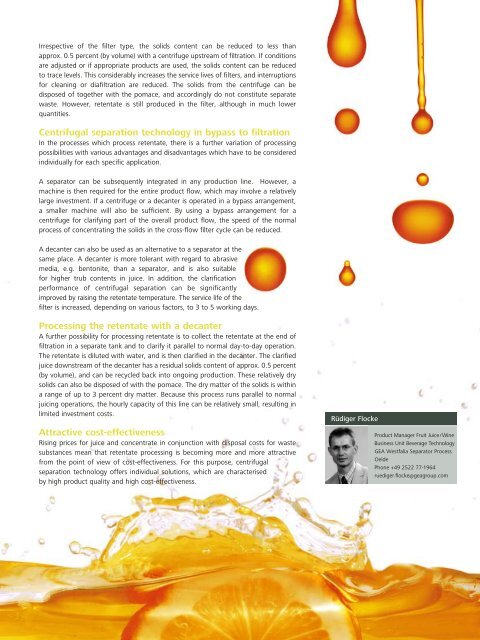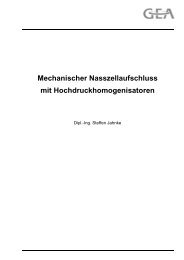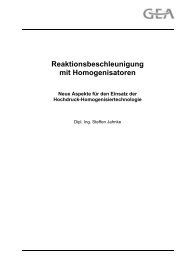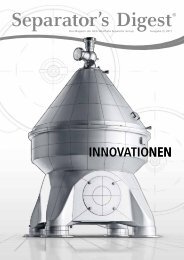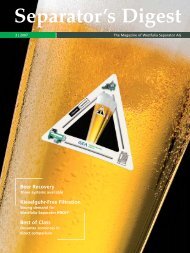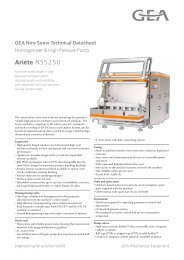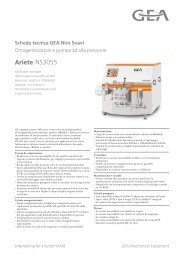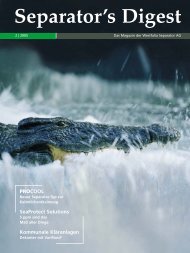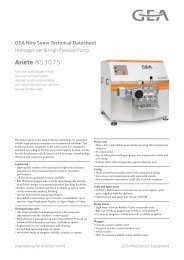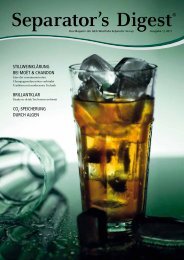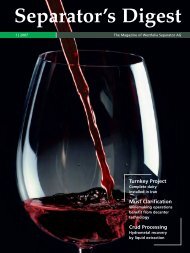Separator's Digest 2009/1 min. - GEA Westfalia Separator Group
Separator's Digest 2009/1 min. - GEA Westfalia Separator Group
Separator's Digest 2009/1 min. - GEA Westfalia Separator Group
You also want an ePaper? Increase the reach of your titles
YUMPU automatically turns print PDFs into web optimized ePapers that Google loves.
Irrespective of the filter type, the solids content can be reduced to less than<br />
approx. 0.5 percent (by volume) with a centrifuge upstream of filtration. If conditions<br />
are adjusted or if appropriate products are used, the solids content can be reduced<br />
to trace levels. This considerably increases the service lives of filters, and interruptions<br />
for cleaning or diafiltration are reduced. The solids from the centrifuge can be<br />
disposed of together with the pomace, and accordingly do not constitute separate<br />
waste. However, retentate is still produced in the filter, although in much lower<br />
quantities.<br />
Centrifugal separation technology in bypass to filtration<br />
In the processes which process retentate, there is a further variation of processing<br />
possibilities with various advantages and disadvantages which have to be considered<br />
individually for each specific application.<br />
A separator can be subsequently integrated in any production line. However, a<br />
machine is then required for the entire product flow, which may involve a relatively<br />
large investment. If a centrifuge or a decanter is operated in a bypass arrangement,<br />
a smaller machine will also be sufficient. By using a bypass arrangement for a<br />
centrifuge for clarifying part of the overall product flow, the speed of the normal<br />
process of concentrating the solids in the cross-flow filter cycle can be reduced.<br />
A decanter can also be used as an alternative to a separator at the<br />
same place. A decanter is more tolerant with regard to abrasive<br />
media, e.g. bentonite, than a separator, and is also suitable<br />
for higher trub contents in juice. In addition, the clarification<br />
performance of centrifugal separation can be significantly<br />
improved by raising the retentate temperature. The service life of the<br />
filter is increased, depending on various factors, to 3 to 5 working days.<br />
Processing the retentate with a decanter<br />
A further possibility for processing retentate is to collect the retentate at the end of<br />
filtration in a separate tank and to clarify it parallel to normal day-to-day operation.<br />
The retentate is diluted with water, and is then clarified in the decanter. The clarified<br />
juice downstream of the decanter has a residual solids content of approx. 0.5 percent<br />
(by volume), and can be recycled back into ongoing production. These relatively dry<br />
solids can also be disposed of with the pomace. The dry matter of the solids is within<br />
a range of up to 3 percent dry matter. Because this process runs parallel to normal<br />
juicing operations, the hourly capacity of this line can be relatively small, resulting in<br />
limited investment costs.<br />
Attractive cost-effectiveness<br />
Rising prices for juice and concentrate in conjunction with disposal costs for waste<br />
substances mean that retentate processing is beco<strong>min</strong>g more and more attractive<br />
from the point of view of cost-effectiveness. For this purpose, centrifugal<br />
separation technology offers individual solutions, which are characterised<br />
by high product quality and high cost-effectiveness.<br />
<strong>GEA</strong> <strong>Westfalia</strong> <strong>Separator</strong> Process 25<br />
<strong>Separator</strong>’s <strong>Digest</strong> 1 | <strong>2009</strong>



